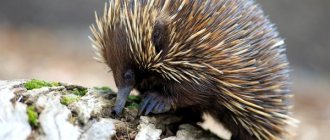Eagles: description
The eagle, as a bird of prey, is known to many peoples of the world. This bird is associated with such concepts as glory, luck, victory and power. That is why this majestic bird can be seen on the coats of arms of many states. Today, many species of eagles are known, which are distinguished by their impressive sizes. Some species boast that their body length is almost 1 meter. As a rule, females are slightly larger than males. The weight of adult individuals ranges from 3 to 7 kilograms. Such species of eagles as the steppe eagle and the dwarf eagle are characterized as the smallest representatives of this family.
Appearance
Representatives of this family have a fairly massive and well-developed body. They have strong and relatively long legs, with feathering down to the toes that looks more like “pants.” At the same time, the head is quite compact in size, and the neck is strong and muscular. The eyeballs are large, but do not differ in noticeable mobility, although at the same time, the mobility of the neck is such that such a defect does not have a significant, negative impact on the life activity of the bird of prey.
Eagles are also distinguished by their rather strong claws and beak. The beak has a curved end, which confirms the predatory nature of the bird. Claws and beaks are characterized by the fact that they grow throughout life, but the peculiarities of the life of eagles lead to the fact that they are worn down naturally. This family has strong, long and wide wings, with well-developed plumage. Their span can reach 2 and a half meters. Such aerodynamic characteristics allow the predator to remain in the air for a long time, at an altitude of about 800 meters, and maybe higher.
Interesting to know! Eagles easily cope with air currents of any intensity. Moreover, they are capable of attacking their prey at a speed of at least 300 km/h.
Eagles have extremely acute vision, so from a height of 500 meters they are able to look out for fairly small prey, in the form of lizards, rodents, snakes, etc. Moreover, the presence of peripheral vision allows the bird of prey to exercise control over 12 square meters of air space. Eagles' hearing is not as developed as their vision, and their sense of smell is generally weak.
The color of the plumage depends on the species of this family, therefore it is characterized as monotonous, with the presence of specks and contrasts. Eagles can be easily distinguished by their flight patterns, their agility and the way they make rare but deep and powerful wing beats.
Behavior and lifestyle
Eagles are a family of monogamous birds, as they choose a mate for life, so they mostly live in pairs. The peculiarity of eagle hunting is that they circle the sky for hours, looking for potential prey on the ground. At the same time, eagles not only look out for their next victim, but also monitor events happening around them. Eagles do not hunt on a daily basis because they are able to store food in their crops for several days.
How long do eagles live?
The average life expectancy of eagles in natural conditions is about 25 years. It should be noted that there are species that live longer. When kept in captivity, steppe eagles and golden eagles can live for half a century. There are cases of eagles living up to 80 years.
INTERESTING FACTS – EAGLES
Who are eagles
Today there are several classifications of eagles. Some species are so similar to each other that ornithologists have to conduct genetic tests to determine which species the bird belongs to.
The formidable predator is unpretentious to its habitats. It can be found in many secluded parts of the globe, where humans are unable to disturb the peace of large birds. Eagles are found in Africa, Europe, Asia and North America. The boundaries of their habitat run along the forest-tundra in the north and deserts in the south.
Birds prefer to settle in the mountains, building nests in rock crevices and on tall trees. Since the eagle is quite massive, has a large body and wide, long wings, the nest should be spacious. For its construction, some species of birds use not only large branches, but also stones.
You can understand how special a predator is by reading interesting facts from the life of birds. So, on average, the wingspan of eagles reaches almost 2 m with a body length of 90 cm. In the air they are able to move at the speed of a sports car (up to 240 km/h). If a predator notices a prey and gives chase, it can accelerate to 300 km/h during a dive.
All representatives of the eagle family are distinguished by their keen eyesight. The bird is able to view prey from a distance of more than 3 km. At the same time, it covers an area of more than 11.5 km². If we consider that, thanks to the special structure of its wings, the predator is able to rise into the air even during a hurricane, then we can say that the eagle is a real master of the air element, having only one enemy - man.
Types of eagles with photos and names
Based on careful research carried out by German specialists at the molecular level, it was found that eagles from the Aquila group are the ancestors of all species of eagles.
In relation to eagles, in our time a revision is being carried out covering all types of taxa, which is associated with a temporary decision to unite all taxa into the genus “Aquila”. For example:
Hawk eagles (Aquila fasciata)
Hawk eagles, which have an average wing length of about 50 centimeters, with a total length of a bird of prey of about 70 centimeters. Their weight is somewhere on average 2 kilograms. The birds are distinguished by their blackish-brown back, gray tail, with a dark pattern located across the plumage. The belly area has lighter shades, buffy or whitish, with inclusions of longitudinal streaks, as well as dark transverse stripes on the plumage, including in the area of the legs and undertail. Females of this species, compared to males, are much larger.
Pygmy eagles (Aquila pennata)
Which, in terms of the size and proportions of their body, are more reminiscent of small buzzards, while the predator’s characteristic eagle-like appearance is clearly visible. The length of the predator is about 50 centimeters on average and the average weight is about 1 kilogram. The wingspan of adults averages about 1.2 meters. Males and females have almost identical colors. These birds of prey have a strongly curved but relatively short beak. The color can be dark or light, although light body color options are much more common.
Indian hawk eagles (Aquila kienerii)
Which are not large in size, with a body length of about 52 centimeters and a wingspan of 1 meter or a little more. The tail of this species of eagle has a characteristic curve at the end of the tail. The upper part of the body is painted in darker tones, and the chin, throat and crop are almost white. The lower part of the body, as well as the legs, have a characteristic reddish-brown tint, with almost black, wide stripes. It is very difficult to distinguish a male from a female.
Golden Eagles (Aquila chrysaetos)
Which are considered large and very strong representatives of the genus with a body length reaching almost 1 meter and a wingspan of up to 2 and a half meters. Females of this species are also larger than males and can weigh almost 7 kilograms. Golden eagles have a typical eagle beak, laterally compressed and high. At the bottom, the beak ends in the form of a hook.
Imperial Eagle (Aquila heliaca)
Which are distinguished by long and wide wings. The tail of Imperial Eagles is straight, and their average length is within 80 centimeters, while the wingspan reaches 2 meters, with a weight of no more than 4 and a half kilograms. The habitats of imperial birds and golden eagles often overlap.
Stone eagles (Aquila rapax)
Growing in length up to 65 cm on average. Moreover, they weigh no more than 2 and a half kilograms, and their wingspan is no more than 1.8 meters. Some varieties of stone eagles have different plumage colors, depending on age, individual characteristics of the subspecies, as well as individual variations in plumage colors.
Steppe eagles (Aquila nipalensis)
With a body length of no more than 86 cm and an average weight of about 3 and a half kilograms or a little more. The wingspan of this predator reaches at least 225 centimeters. Adult individuals are distinguished by a dark brown plumage color, with a red spot in the nape area, as well as primary flight feathers, colored in black-brown tones. The tail feathers are dark brown in color, with transverse stripes of a grayish tint.
Greater Spotted Eagle (Aquila clanga)
Greater Spotted Eagles and Lesser Spotted Eagles, although the populations of these birds are not large at all. They represent birds of prey from the Accipiterae family, which can be classified as birds of the genus Lophaetus or Ictinaetus.
Kaffir eagles (Aquila verreauxii)
With a body length ranging from 70-95 cm, with a wingspan reaching two meters, this type of bird of prey weighs 3.5-4.5 kg.
Moluccan eagles (Aquila gurneyi)
Which are also distinguished by their considerable body size, reaching a length of at least 90 centimeters. Females weigh about 3 kilograms, with a wingspan of about 180 centimeters.
Silver eagles (Aquila wahlbergi)
Representing diurnal predators, with a body length of up to 60 centimeters and a wingspan of up to one and a half meters. Silver eagles are found in many African countries.
Wedge-tailed eagles (Aquila audax)
Which are considered quite large in their kind, since they have a body length of almost 1 meter, and their wingspan is within 2 meters or a little more. Females are larger than males and can weigh up to 5 kilograms.
The fossil species of eagles is the Reliocene (Aquila kurochkini). Its average size is comparable to modern hawk eagles at the morphological level.
The situation with the abundance of the species
In order to exist normally, the bird needs lands where there is no place for human activity. However, vast expanses of steppe are now being converted into arable land. This directly affects the population size. The extermination of rodents also affects the number of bird predators. Various chemicals used by people to preserve crops also have a harmful effect on the body of birds.
Return to article: Snowy owl
♦ ♦ ♦
There are several different species of eagles. In most cases, these birds are inhabitants of the temperate and subtropical zones of Eurasia. Eagles can be found from Scotland to Mongolia, Kazakhstan and India. The wedge-tailed variety of birds lives in Australia. Crested and crested eagles are found throughout Africa. The most common species is the steppe eagle, which inhabits the territory of the Czech Republic, Slovakia, Ukraine, Spain, and Turkey.
Natural habitats
The habitat of eagles is quite extensive, and each species has chosen unique territories for itself. It is worth noting that there is one feature: these places are located as far as possible from a person and his life activities. In this regard, eagles are found more often in mountainous areas or in semi-open landscapes.
If we take golden eagles, they live on the territory of our country, starting from the North Caucasus and ending with the southern regions of Primorye. For their nesting they choose hard-to-reach forest areas. Wedge-tailed golden eagles, which can be considered relatives of golden eagles, prefer to nest in forest plantations of New Guinea. Steppe eagles live in steppe zones, as well as semi-desert zones located between Transbaikalia and the Black Sea coast.
Imperial Eagles have long been found in the forest-steppe zones of Ukraine, in the steppes of Kazakhstan, in the forests of the Czech Republic, Romania and Spain. In addition, similar species of eagles live in the territories of Iran and China, Slovakia and Hungary, Germany and Greece, as well as other European countries.
Many peoples tame golden eagles and then use them in hunting as birds of prey.
Behavior and nutrition
The feathered predator hunts mainly small animals. These are mice, voles, hamsters, gophers. Such preferences have a positive effect on agriculture, because rodents that harm crops are destroyed. The steppe eagle's area of interest also includes hares, lizards, snakes and birds. While hunting, the predator can run on the ground. At the same time, he jumps slightly and flaps his wings.
Victims are observed mainly from the air while hovering above the ground. In some cases, the steppe eagle watches for rodents near the hole. He can not only sit, but also lie down, patiently waiting for the same gopher to poke his head out of his shelter. The bird runs superbly on the ground and easily catches up with its prey.
Diet
The diet of eagles is quite extensive, and mainly consists of objects of animal origin, often quite large, although these food objects are mainly small hares, gophers, birds and fish. If eagles go hungry for a long time, they can easily feed on carrion, which they find either on land or in water.
Interesting information! The raptors have been documented to feed on a wide variety of animals, including black lofurs, domestic and wild chickens, spur and bush partridges, green and domestic pigeons, kingfishers and even squirrels.
If the hunt is successful, the eagles eat their prey immediately or feed it to the chicks. Some species of eagles hunt quite poisonous snakes. After eating, the eagle drinks it with plenty of water and begins to tidy up its plumage.
EAGLE IN ACTION! Eagle attacks on wolves, dogs, kangaroos...
Dietary features of the eagle
The eagle's diet is based on small and medium-sized vertebrates; the bird can rarely feed on carrion.
— Advertising —
Eagles hunt very effectively. In search of prey, these birds can soar in the air for a long time, or they look out for their victims, sitting on elevated places. Eagles are excellent at hunting other birds. They always overtake their prey by surprise, as they attack from such a height at which the victim simply does not see them. The eagle also dives with great speed, which leaves the prey no chance of escape. This is how eagles catch birds in flight.
In addition to independently obtaining food, eagles are also prone to robbery - they easily take caught prey from small birds of prey right on the fly.
Reproduction and offspring
It is characteristic of eagles that they reach sexual maturity only at 5 years of age. Depending on the type of predator, eagle nests can be found in bushes or trees, as well as on rocks high in the mountains. Both the female and the male are involved in the construction of the nest, although it is believed that the female puts in more labor, skill and care. Once a nest is built, if it is secure, eagles can use it for many years.
There are cases when eagles capture nests built by large birds, such as a falcon or raven, of course, if these nests suit the eagles due to their size. The female lays eggs once a year, and their number is no more than 3. Hatching eggs is practically no different from hatching eggs of other birds. After birth, you can already understand from the chicks that the birds have a complex predatory character. As a result of squabbles inside the nest, weaker individuals often die. They may be thrown from the nest or receive fatal blows from the beak.
Important point! The mating games of eagles are a spectacular sight as they take place in the air. Both individuals demonstrate all their capabilities, chasing each other and performing complex aerobatics.
Gravedigger eagles are considered the most responsible parents because they take turns incubating eggs. After a month and a half, the offspring are born, and after 3 months the parents teach their offspring the basics of flight. Since they have excellent flight training, they make long migrations in winter.
Steppe eagles are also of particular interest in this regard, since their nests are located directly on the ground. The eggs are hatched by the females, and the male feeds his other half all this time. Both parents also take part in the upbringing and education of their offspring. Young eagles travel great distances in search of a mate. After finding a mate, they begin to build a nest for themselves and begin to lead a sedentary lifestyle.
Marriage relationships and lifespan
Formidable predators are monogamous creatures. They find a mate upon reaching puberty and never leave each other. How long does an eagle live in a family? Ornithologists know of a pair of birds that existed for more than 35 years. Knowing how long eagles live, this period seems enormous. Indeed, in their natural habitat, the average life expectancy of predators does not exceed 25 years.
How many years do birds live? Condors have the longest lifespan. Based on the results of numerous observations, it was found that their lifespan reaches 65 years. Condors are the largest flying birds in the Western Hemisphere. The place where eagles of this species live is the American Andes. Birds feed on fresh carcasses of dead animals and do not disdain carrion. In search of prey, birds fly over mountain valleys more than 200 km every day. In the absence of large food, they can destroy bird nests by attacking chicks.
In nature, young eaglets begin to hunt as early as 3 months, but can create a pair only at the age of 4-5 years. From the moment of birth, eagle chicks actively fight for existence. The stronger individual tries to push the weaker fellow out of the nest for two months. If the latter survives, then relations will improve and the chicks will live out their time in the nest peacefully.
Another interesting fact is that even the largest birds by weight are able to mate in flight. The mass of an individual depends on how long the eagle lives. But, regardless of this, female predators are always larger than males. This fact does not prevent devoted gentlemen from not only helping their friend eat and hunt while hatching eggs, but also doing this themselves.
A large bird also hunts in the air: it is capable of catching up with a smaller fellow and taking its prey.
Natural enemies of eagles
And yet, eagles, despite the fact that they have practically no natural enemies, represent a rather vulnerable link in the planet’s ecosystem. As a rule, eagles often die in fights with stronger aerial predators, as well as with an ordinary wolf.
But this is not such a big problem compared to the lack of food for many days. Due to the fact that the eagle's body requires constant and stable food, they have to migrate together with other species of birds to warmer regions or countries.
Important point! When there is enough food for eagles, as a result, more chicks survive in their nests, and when the food supply is scarce, then, as a rule, only one, but the strongest chick survives.
As the results of various observations and studies show, human economic activity is to blame for the decline in eagle populations. As humans develop more and more areas of the landscape, this leads to the fact that eagles experience a shortage of food. The thing is that many food chains either migrate to other areas or disappear altogether. As a result, many birds die from hunger. Eagles are often electrocuted as they attempt to build their nests on power lines (poles).
Are eagles dangerous to humans?
An adult eagle has everything it takes to cause significant harm to human health. It cannot be said that attacks are regular, but there were times when a person became the target of an eagle attack. For example, a crowned eagle that lives in the tropical forests of Africa once attacked a small child and tried to drag him away. The bird's attack was repulsed simply because the eagle was unable to lift its potential victim into the air.
News and society
Population and species status
Some birds of prey belonging to the hawk family have the protection status of “Least Concern”. These include:
- Hawk eagle.
- Indian Hawk Eagle.
- Golden eagle.
- Stone eagle.
- Kaffir eagle.
- Silver eagle.
- Wedge-tailed eagle.
- The following species of birds of prey have received the “Vulnerable Species” conservation status:
- Imperial Eagles.
- Spanish burial grounds.
- Greater Spotted Eagle.
The steppe eagle has received the status of an endangered species, and the Molucca eagle has the status of close to vulnerable. Birds of prey such as the dwarf eagle and imperial eagle are listed in the Red Book in some countries.
These birds are distinguished by their special temperament and unbending will. The eagle is a bird that in many cultures has become a symbol of courage, pride, bravery and other positive qualities.
2. The Romans believed that the eagle was the squire of Jupiter’s smog; it was supposed to store and carry formidable lightning.
3. The eagle has a powerful body and long, wide wings. The eagle’s beak is massive, its paws end in claws curved inward, and “pants” are formed on the hips with feathers.
4. In nature, eagles are one of the most formidable representatives of birds, and the only creature that poses a real threat to them is a person who displaces eagles from their usual habitats. Despite this, there are still many places on Earth where eagles are found in abundance.
5. Males often help eagles hatch eggs.
6.The wingspan of an eagle reaches 2.4 meters with a body length of up to 88 centimeters.
7.Female eagles are much larger than males.
8. The flight altitude of eagles is up to 7-9 kilometers. Not every plane can reach such a height.
9.Eagles can mate in flight.
10. In many countries, the eagle symbolized absolute power. This gave confidence, the person felt like the chosen one of the gods. The Aztecs made jewelry from eagle feathers. The military elite wore cloaks embroidered with jewels and eagle feathers, which resembled the wide wings of a bird of prey. Sandals tamed by the claws of eagles.
11. Eagle nests are the largest nests that birds build. Eagles build their nests at the maximum height available in a given area. They do this to ensure safety for the chicks, to have an excellent vantage point and ambush site at the same time, and to take off with less effort. Every year they expand and complete their nests.
12. A predator’s gaze is capable of focusing on two objects at the same time (a person can focus on only one).
13. Eagles have fantastic vision, it is six times better than that of humans. Eagles fly out to hunt during the daytime. The bird is not disturbed by the sun's rays or glare of water; they can easily see the smallest objects and small animals in the grass from a bird's eye view.
14. Looking at the eagle, it seems that it is slowly soaring on huge wings. In fact, the bird flies with amazing speed, a misleading impression arises because the bird flies at a great altitude (not lower than 700 meters).
15. Eagles are capable of taking prey from a smaller bird even in flight or attacking it itself.
16.If two chicks appear in an eagles nest, the stronger one will try to get rid of the other for 2 months. If the weak chick manages to survive, then they begin to live quietly in the nest with each other.
17. With the help of strong claws, the eagle tenaciously grabs the victim not only on the ground, but also in the air.
18. Usually a couple has two eaglets in a year. The family life of eagles resembles the everyday relationships of people. The male must get food, the female raises and feeds the babies, and protects the nest.
19. Perfect aerodynamics are vital for eagles, so if a bird loses a feather from one wing, the same feather will fall out of the other.
20. In antiquity, eagles were considered a symbol of victory and good luck, and in Egypt and China - a symbol of the sun.
21. Eaglets begin to hunt independently when they are 3 months old. These birds reach full maturity by 4-5 years.
22. An eagle can lift into the air a prey weighing equal to its own.
23.Eagles are excellent at hunting flying birds. They overtake the prey by surprise, as they hunt from such a height that the bird cannot see them. And then they dive at such a speed that the prey does not have time to notice them.
24. Sometimes, if the eaglet does not dare to leave the nest, the parent sits in front of the nest with prey and begins to call the timid eaglet.
25. Eagle eyes are closed by two eyelids: transparent and dense. The first, completely transparent, are adapted to withstand prey or strong winds. And the latter allow you to sleep.
26. During flight, an eagle soars above the ground at a speed of 200 km/h. At the sight of a potential victim, the bird can accelerate to 320 km/h.
27. From a flight altitude, an eagle is able to see prey on a surface area of 11.5 kilometers, and with a peripheral glance it can cover 270 degrees.
28. Eagles are effective in hunting, but they do not kill unnecessary animals; they only catch for their own food and for their chicks.
29. The skeleton of an eagle weighs half as much as its feathers.
30. The eagle is present on the coats of arms of many countries of the world, including Russia.
31. Eagles are very faithful birds; they mate for life. Some ornithologists discovered a pair of eagles that had lived together for more than thirty-five years.
32. Eagles mainly hunt small game, but they are capable of lifting a small fawn into the air.
33. After 40 years, the beak and talons of eagles of large species grow to such an extent that the birds practically lose the ability to eat and hunt. There are two options for the further development of events: the eagle either dies or breaks its beak on stones, pulls out its claws and old feathers, and six months later it is reborn like a phoenix to live on and lives for many more years. One can only envy such strength of character.
34. A proud bird flying so high was taken in Hinduism, Christianity and other religions as the embodiment of the divine face.
35. The special design of eagle wings helps them fly calmly even in a hurricane.
photo from the Internet
Man and eagles
The image of an eagle is located on the coat of arms of Russia, although eagles represent a rather rare category of birds of prey, and therefore are listed in the Red Book. Eagles, as a symbol of strength and endurance, are on the verge of extinction as a species, all thanks to the economic activities of people. The constant decline in the number of birds of prey is due to many factors, including poaching, as well as the constantly deteriorating environmental situation.
Thanks to the presence of the Red Book, as well as specialists, it is possible to constantly monitor and discover new species of eagles that are in danger. This allows you to respond to such problems in a timely manner, changing the situation for the better.
How long does an eagle live? How many years do steppe eagles live?
From Masterweb
How long does this type of predator live? First, let's present a short story about this bird.
About 30 years ago, the steppe eagle was the most numerous species among these predators in Northern Eurasia. Today, the number and area of its distribution have sharply decreased. The population of the species worldwide does not exceed 60 thousand pairs, and only up to 3.5 thousand pairs nest in Russian territories. They are included in the Red Book of Russia.
Such changes are directly related to human activity: severe depletion of the food supply due to the active use of pesticides in agriculture, human development of the steppes, destruction of nests and shooting of birds. It has also been established that the steppe eagle suffers more than its other relatives from electric lines, since in the absence of trees in the steppe area, it uses poles instead of hunting perches and dies from the effects of current.
The steppe eagle is widespread in the semi-desert and steppe zones of Northern Eurasia. These are the territories of Russia, China, Mongolia and Kazakhstan. The largest population lives in Kazakhstan (up to 50 thousand pairs).
How many years do steppe eagles live? Their average life expectancy is relatively long. In captivity, they often live up to almost 50 years, and in nature - less, although there is no exact data on this.
How long does this type of predator live? First, let's present a short story about this bird.
About 30 years ago, the steppe eagle was the most numerous species among these predators in Northern Eurasia. Today, the number and area of its distribution have sharply decreased. The population of the species worldwide does not exceed 60 thousand pairs, and only up to 3.5 thousand pairs nest in Russian territories. They are included in the Red Book of Russia.
The steppe eagle is widespread in the semi-desert and steppe zones of Northern Eurasia. These are the territories of Russia, China, Mongolia and Kazakhstan. The largest population lives in Kazakhstan (up to 50 thousand pairs).
How many years do steppe eagles live? Their average life expectancy is relatively long. In captivity, they often live up to almost 50 years, and in nature - less, although there is no exact data on this.
The steppe eagle belongs to the hawk family of the genus eagles. The bird's population is insignificant and is steadily declining throughout its habitat. The feathered predator lives in steppe regions and semi-deserts. Birds of northern latitudes migrate south in winter. The inhabitants of the southern lands lead a sedentary lifestyle.
Indian Hawk Eagle
The peculiarity of the bird is its tail with a rounded end. The color is brown with a brick-red tint. The chest and belly are completely white.
Indian hawk eagles require a humid tropical climate, so they choose the forests of Indonesia, the Philippines, Indochina and Malaysia for settlement.
Hawk eagle
The bird lives mainly in tropical climates on the African continent and Asia. In European countries it is on the verge of extinction due to human impact.
The average weight of a hawk eagle is 2 kilograms. Body length reaches 70 centimeters. Females are significantly larger than males.
The plumage is dark brown with a transverse gold pattern on the neck and head. The abdomen is light with black speckles, the iris of the eyes and paws are yellow.
Lifespan of an eagle
Eagles are considered long-livers; ornithologists have recorded cases where an adult bird managed to live up to 80 years. The mountain eagle in the wild lives on average 25-30 years. It is noteworthy that eagles choose one to mate for life.
Features and habitat of the eagle
The habitat of a given species of bird is also determined by the individual characteristics of the species. The steppe eagle is a regular in the steppe and semi-steppe zones. Eagles can also live in dense forests or open coastal areas. The close proximity of rivers, lakes and swamps attracts this bird. Some species of eagles can live freely in the desert or build their nests high in the mountains.
In nature, eagles have quite a few natural enemies. A large individual of this bird can die only in a fight with a wolf. However, despite this, eagles are a rather vulnerable link in the natural system. This tendency is associated with a complex search for food. Hunger is the main reason for the migration of these birds.
In addition, eagles quite often die on power lines while trying to set up their own home.
Eagles have a massive build, large and wide wings. The birds have large beaks and strong legs with rounded claws. They fly very high, tracking down prey with ease thanks to their vision. In general, not even due to vision, but due to the fact that the bird has a very developed neck. But the sense of smell is very poor.
Females are always slightly larger than males. Almost all eagles are very large, up to 6 kg. They live in steppes, forests and mountains - depending on the species. They prefer to settle in temperate and subtropical zones. Seven out of thirty live in Russia. The eagle is a proud bird - everyone says this, and the bird owes this to its way of life. Birds do not nest in crowded places.
The diet of eagles is amazingly diverse. The diet includes small mammals (especially rodents, or the same hares), and amphibians (frogs, for example), and reptiles (turtles, snakes, lizards), as well as other birds. Predators also hunt large animals: sheep, roe deer or deer. Birds do not disdain carrion.
Interestingly, eagles can also hunt in pairs. Usually they soar in the heights and look out for game, which they then attack. But they can also attack from an ambush, which is most often arranged in a tree. For each prey they have a separate method of killing.
READ How long do laliuses live?
Eagles are widespread in Eurasia, Africa and North America. Their numbers are quite low, so birds are rarely seen. The highest probability of meeting them is in mountainous areas.
They can live both in the steppes and be mountain birds living in the mountains. The golden eagle is the largest eagle bird, weighing up to 6 kg. The wingspan of these birds reaches three meters. Thanks to its wings, the bird can easily soar in the skies for hours, and when it sees a prey, it dives sharply in its direction.
In the photo there is a golden eagle bird
The color is dark brown, the beak is a typical shape for eagles. This species has the longest tail of any bird. The cry of the golden eagle is typical for all species of the family. They hunt during daylight hours, feeding on squirrels, martens and birds. Golden eagles can be found in Africa, America and Eurasia. They live in almost all areas, including savannas and mountains.
They nest on hills (trees and rocks), nests are located at a distance from each other, because they have extensive hunting areas. Females lay no more than two eggs, but both parents are involved in feeding the chicks.
The smallest of this bird species is the pygmy eagle. This bird is characterized by migration, preferring Asia, Africa and southern Russia. It is interesting that females are larger in size than males. There are no more differences in their description.
Pictured is a dwarf eagle
Description of the dwarf eagle bird: – stocky body; – the lower part of the body and tail have white plumage; – flight wings are black; – paws are yellow, with black claws; – the beak of the dwarf eagle bird is small, strongly curved.
The steppe eagle is a beautiful and majestic bird. There are similarities with the golden eagle, but it is slightly smaller in size. This bird loves open space, which is why it lives in fields and steppes, and hunts there. – The color is dark brown; – with a reddish occipital spot; – beak almost black; – paws are bright yellow; They live in Asia.
Pictured is a steppe eagle
Large bird of prey, Imperial Eagle. The bird can live both in the south and in the north (migratory). The body color is dark brown, the head and neck are yellow. The tail is brown, monochromatic. I fly in pairs or alone. They float slowly in the sky. The wing length is more than half a meter.
In the photo there is a burial ground eagle
The bald eagle is a bird of prey. This type of bird is an eagle with a white head. This bird is a symbol of America. All plumage is brown except the head and tail. The beak and legs are yellow. There is no feathering on the legs.
The weight of an adult individual reaches from 2 to 7 kg. Body length can be up to 100 cm. It feeds mainly on fish. The bird flies over the water and grabs prey with its claws. The average lifespan of a bald eagle is 20 to 30 years.
Pictured is a bald eagle
The osprey bird lives in both the southern and northern hemispheres. The length reaches 50-60 cm, the wingspan is more than 1.5 meters. It is not the largest eagle species in size, weighing up to 2 kg. The wings are long and brown. The legs and beak are black. The female lays up to 4 eggs. The osprey lives for about 10 years.
In the photo there is an osprey bird
Stone eagle
The color of the bird can be found in light and dark variations of brown. Females are larger than males and reach 2.5 kilograms. The body length is on average 65-70 centimeters.
Stone eagles prefer to live at an altitude of 3000 meters above the sea, in the steppe or savannah. Distributed throughout Asian countries, Western and Southern Africa.
Wedge-tailed eagle
One of the largest species of eagle. The body length can reach 1 meter, and the wingspan can be more than 2 meters. Females are much larger than males, growing more than five kilograms. The color is dark brown with red half rings on the feathers.
To build nests, it selects plains and plains, and mountainous areas. Distributed in Australia, New Guinea.
What is the difference between an eagle and a hawk
Often people who are far from ornithology confuse the eagle with other birds, hawks or kites.
The main difference between a hawk is the smaller body size of the bird. The representative of the hawks has short, rounded wings, but the tail, on the contrary, is large with long feathers. Unlike eagles, hawks cannot soar. In the air, they tend to make rapid movements with their wings.
The kite has a weak, small beak, long wings and a tail that looks like a fork. Unlike eagles, kites do not need to hunt live prey; they only need carrion for food. And to create nests they choose tall but lonely trees.
Moluccan eagle
A distinctive feature of the bird is its long dark tail. The wingspan can reach up to 2 meters. The weight of a typical representative of the Moluccan eagle is about 3 kilograms, the body length grows to 85 centimeters.
There are only a small number of birds left in the world; their nests are built at an altitude of 1500 meters above the sea. It is found in only two places in the world: Indonesia and Papu New Guinea.
Silver eagle
Silver eagles live in northern Africa because they require dry habitat to live.
The color of the feather covering is light brown, with a light silver tint at the end of the feather. Body length 55-60 centimeters.











